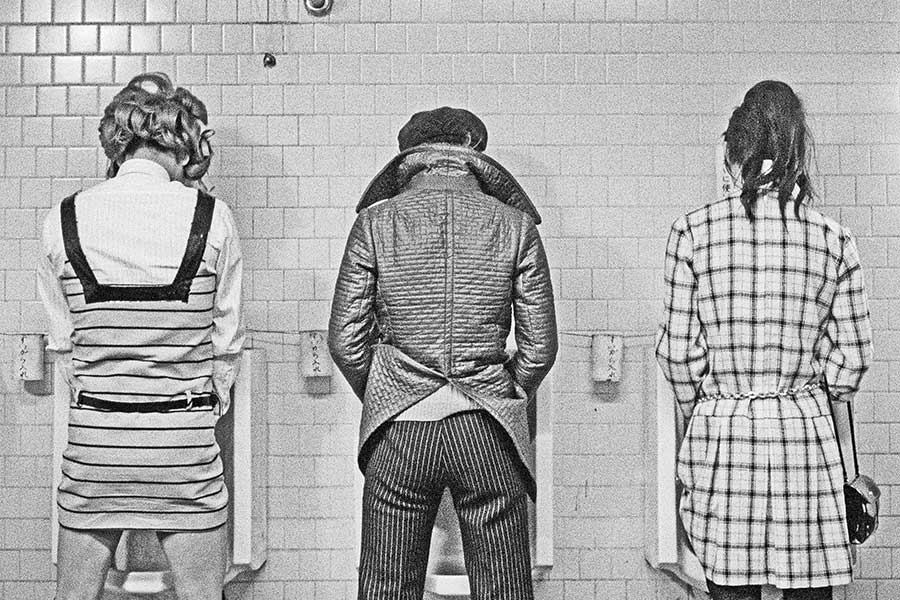The Lightbox Film Center is presenting a fabulous new restoration of the late Toshio Matsumoto’s 1969 underground classic, “Funeral Parade of Roses.” Long unseen in the United States, the film will screen in Philadelphia at 7 and 10 p.m. July 29. This film, gorgeously shot in black and white, mixes experimental and documentary film styles and incorporates many visual effects, including speed-up and slow-motion photography, as well as flashback/flash-forward editing to create a literally eye-popping spectacle. (Spoiler alert: The film is a queer reworking of “Oedipus Rex.”)
Eddie (the mono-monikered cross-dressing actor Peter, who later appeared in Akira Kurosawa’s “Ran”) dresses up as a woman because, as he explains in a documentary interview, he feels satisfaction “being myself.” Such candor was no doubt rare in Japan back in 1969, and it feels no less revealing today.
Eddie is first seen having an erotic tryst with Gonda (Yoshio Tsuchiya), the male owner of Club Genet, where Eddie works. The couple talks flirtatiously after, but later, in a car driving away from their assignation, Eddie swears he has seen Leda (Osamu Ogasawara), a rival drag queen at Club Genet. Eddie fears Leda will get revenge for his stealing Gonda from her.
That plot comprises some of “Funeral Parade of Roses,” and the story, which does not follow a linear narrative, comes back to the scene in the car multiple times. In between, there are deliciously bitchy moments between Eddie and Leda, calling each other nasty names before getting into a delirious catfight shot in high speed.
Matsumoto employs strong visuals throughout his film, including photo-negative images, extreme close-ups and odd camera angles to create a very avant-garde film. (Stanley Kubrick cited the film as an influence for “A Clockwork Orange.”) The editing in “Funeral Parade of Roses” is also appropriately avant-garde. One sequence has a noodle-carrying bicyclist having an accident, and quick flashes of the noodles on the street perhaps foreshadow guts being spilled. Other quick shots are cut to multiple times. These include a woman recoiling and bleeding from the stomach to seven naked men, seen from behind, one of whom has a flower sticking out of his ass. These moments may not contribute much to the plot, but sometimes they are explained.
Matsumoto includes some scenes that stand alone, but also contribute to the points in the film. A sequence set in a gallery showcases images of “masks” as a voice-over discusses masks being a way that people hide themselves. The parallel to Eddie and his friend’s dressing up in drag are obvious. But scenes of three “gay boys” (as the film calls Eddie and his drag-queen friends) shopping around town and eating ice cream, or standing in front of urinals in skirts in a men’s room, or even meeting and fighting a trio of “real” women, are fun, diverting moments that don’t demand much scrutiny. Another variation on the “mask” idea involves Eddie having rather intense and erotic (but not explicit) sex, only to reveal the scene is a pornographic movie he is filming. He explains in an interview that he is just doing what the director tells him. Perhaps Matsumoto’s film should also not be taken at face value.
“Funeral Parade of Roses” was likely very provocative in its time, and while it is still quite striking, it is perhaps more of a curiosity piece today. The depiction of the “gay boys” is frank and mostly respectful. Even if the characters are engaging in some sordid behavior, they come across as real people, not caricatures being ridiculed.
Other characters show up in various subplots. One of the most notable is Guevara (Toyosaburo Uchiyama), a Japanese beatnik type who wears a beard like his namesake Che Guevara that he literally sneezes off in one playful scene. He is part of a filmmaking collective that worships Jonas Mekas and other avant-garde directors from the 1960s era. They want to take drugs (but they don’t have any), though there is a long scene of a joint being passed around by a handful of people. Another extended sequence involves a group of underwear-clad men and women trying to walk a straight line or dance. This episode is revealing simply because it reflects a “wild” scene from a past era with quaint affection.
And this kind of nostalgia may be the best lens through which to view “Funeral Parade of Roses.” The film is uneven, with moments that may confound or confuse viewers, but there are many scenes that are compelling. It ends with a shocking and gruesome act that is quite disturbing. As such, it is best for audiences to let “Funeral Parade of Roses” wash over them and enjoy the outrageous ride, connecting the various dots as they see fit.

